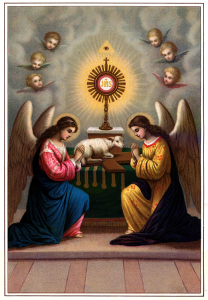Next week, April 16 from 8 pm until 9 pm the Troop is hosting a holy hour (Eucharistic Adoration) during the 150 hours of adoration in celebration of the 150th anniversary of the founding of Saint Joseph’s. Attending this holy hour will count towards activity 3 for the Divine Mercy Emblem, and Activity 5 for the Eucharistic Adoration Emblem. The Holy Hour is during the last part of the troop meeting. I will send more information about this separately.
Attendance at the Holy Hour is optional; though, I hope that the entire family will join us for this 1 hour. I promise an hour of uplifting adoration.
This Sunday is Divine Mercy Sunday. It is celebrated on the first Sunday after Easter. Please note that you need to complete ALL the requirements in order to earn either patch. Turn in all the paper work to Melissa (with your answers). Parents may confirm that the activities have been completed.
Divine Mercy Emblem
How to start
- Read about the Divine Mercy devotion. You may find the answers to these questions on:
- Feel free to use other resources.
- 6th – 12th Grades – Complete 4 requirements and 3 activities OR visit a Divine Mercy Shrine with your family/group. (Holy Rosary in Baltimore is the Archdiocesan Shrine of Divine Mercy http://www.holyrosarypl.org/en/shrine/)
Divine Mercy Activities
- Learn the prayers for the Divine Mercy Chaplet.
- Pray the Divine Mercy Chaplet with your family or Unit.
- Spend an hour in Adoration of the Blessed Sacrament and keep in mind the three Divine Mercy messages: A – Ask for His Mercy; B – Be Merciful; C – Completely trust in Jesus.
- Draw a picture of the apparition of the Divine Mercy. Display it in your home.
- Comfort the sick.
- Attend Divine Mercy Sunday Devotions. Held the Sunday after Easter, a plenary indulgence is received if you go to Confession, receive the Holy Eucharist and pray for the intentions of the Holy Father. Learn more about a plenary indulgence.
Requirements
- Who did the Lord appear to in 1931?
- Describe the vision this person saw.
- Our Lord asked for special prayers and devotion at a specific time of the day. What is that time, and what makes it ‘special’?
- In 1935 a vision was given that prompted St. Faustina to pray for God’s mercy. What is the name of the prayer she said on her rosary.
- The Divine Mercy Novena of Chaplets asks for prayers for different intentions on each of nine days. The Novena begins on Good Friday and ends on Mercy Sunday (the first Sunday after Easter). What are those intentions?
Eucharistic Adoration Emblem
How to start
You may find answers in these resources:
https://glorifyprovidence.com/documents/2015/2/YCM_Adoration_Resource_2.pdf
https://www.arlingtondiocese.org/Youth-Ministry/RM_Helping_Young_People_Fall_in_Love_with_Jesus.pdf
- 6th – 12th Grades – Complete all requirements
Requirements
- After reading John 6:48-52, answer the following question:
- Is Jesus truly present in the Blessed Sacrament? Why? And after reading Matthew 26:26-30 and Matthew 26:36-46, answer the following questions:
- When did Jesus Institute the Eucharist?
- Why do people traditionally spend an hour with Jesus in Adoration.
- Answer the following questions:
- What is the name of the sacred vessel the Blessed Sacrament is placed in during public Adoration? Why are there rays that normally surround the center of this vessel?
- What are Exposition and Reposition?
- What is Benediction, why is it so special, when does it occur, and why does the priest or deacon wear a humeral veil during it?
- Sing the traditional Adoration song “Come Adore” (English version of Tantum Ergo) from your parish hymnal with your parents or counselor. Discuss the song‘s meaning and how it can help you draw closer to Jesus in Adoration?
- With help, make a list of at least six things you can do in quiet Adoration and create an Adoration Bag to take to church with you.
- After discussing how you should behave during Adoration do one of the following:
- Participate in a Guided Adoration for Children.
- Spend a quiet half hour of Adoration on your own.
- After reading about the Story of Fatima and the Angel of Portugal’s visits to the three shepherd children in Fatima, discuss the angel’s third visit. Say the prayers taught to the children by the angel and Our Lady of Fatima. Discuss with your counselor or parents which prayer in most meaningful to you and why.
- Define Transubstantiation. (The Catechism or YouCat are good starting places).
- Pray the Rosary, using the Luminous Mysteries. Pay close attention to the 5th Mystery: The Institution of the Eucharist.
- Create a brief report on a Eucharistic Miracle.
